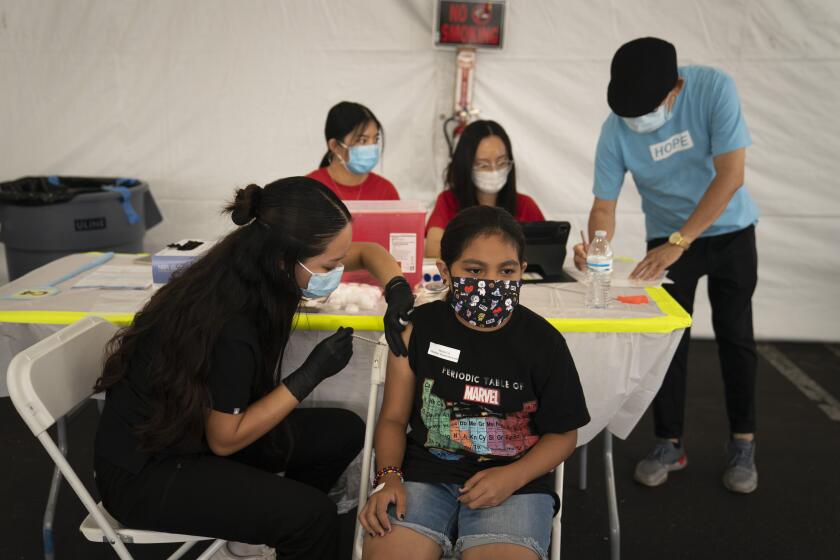Commentary: Don’t be puzzled by evolving mammogram guidelines

- Share via
New draft recommendations released recently from the U.S. Preventive Services Task Force urge all women to get a mammogram every other year, starting at age 40. This reversal from the task force’s previous recommendation for women to start mammograms at 50 may on the surface seem confusing, but it boils down to saving more lives.
To understand why the recommended changes came about, it’s important to consider what the researchers reported. They found a worrisome trend of increased breast cancer diagnoses among women in their 40s. The experts also considered high death rates among Black women who, when diagnosed in their 40s, have twice the mortality rate of white women.
The task force’s review indicated the new guidelines could increase breast cancer survival rates by almost 20% and avert 1.3 additional breast cancer deaths per 1,000 women.
Earlier screening aligns with the National Comprehensive Cancer Network’s guidelines that women should first undergo a breast cancer risk assessment at 25, with annual mammograms starting at age 40 if they are considered at average risk of developing breast cancer. The American Cancer Society recommends women have the option to start yearly screenings at 40 to 44 and have annual mammograms from age 45.
All of this data points to one thing: Starting mammograms makes sense. More importantly, it can save lives.
The task force’s recommendation is welcome news to many women. Leslie Bruce Amin, a Laguna Beach resident and mother of two, is one of them.
With a healthy lifestyle and no genetic markers, Bruce Amin was diagnosed with stage 2 breast cancer at age 37. A strong proponent of wider access to breast cancer screenings, she welcomes these new guidelines. Bruce Amin had her annual appointment and a breast exam just a few months prior to diagnosis, and nothing yet was palpable. If she had the option of getting a mammogram at that time, the cancer may have been detected.
Breast cancer’s impact on younger women is growing — around 9% of all new cases of breast cancer in the U.S. occur in women under the age of 45 — and Bruce Amin is a living testimony to the importance of breast cancer screenings for women in Orange County.
The CEO of CalOptima Health says the return of eligibility checks may catch many county residents insured through Medi-Cal off guard.
In fact, according to the National Cancer Institute, the incidence rate of breast cancer in Orange County is higher than the rest of the state of California. Each year, approximately 13,000 under 40 in the U.S. receive a breast cancer diagnosis. In Orange County, one in seven women will receive that diagnosis in their lifetime.
For women of average risk, we know that mammography remains the most effective way to detect cancer early, when it is most treatable. It is not perfect. Factors such as age and breast density may result in false-negative or false-positive results, and mammograms in younger women can be challenging to interpret. However, it is currently the best tool we have to counter these concerning rising trends.
As a breast cancer specialist, I’ve treated women of all ages with breast cancer. I know far too many women diagnosed with cancer in their 30s, 40s and even 20s. Prevention and early detection are so important in our fight against this disease.
Where you get your mammogram and any follow-up care matters, too. At NCI-designated comprehensive cancer centers, highly specialized experts use FDA-approved 3D mammography called breast tomosynthesis. This technology helps better detect the early signs of breast cancer. Additionally, specialists on the leading-edge of breast cancer care are exploring advanced technology, such as machine learning algorithms to analyze mammograms and identify patterns that can better indicate breast cancer’s presence and lead to earlier and more accurate diagnoses than ever before.
Should you receive a positive diagnosis, you absolutely want the very highest levels of expertise for your individual diagnosis. Next-generation genome sequencing, adaptive immunotherapy, gene therapy and precision medicine are moving us away from the historic “one-size-fits-all” approach to treating disease, and the outcomes are very encouraging.
Of course, these guidelines are for women of average risk. Factors that could put you at higher risk include a BRCA1 or BRCA2 inherited gene mutation, a personal history of breast cancer and particular family histories.
With these or other risk factors, more intensive screening may be recommended, for example with a breast MRI. Again, a breast cancer specialist at an NCI-designated comprehensive cancer center can help guide your course of care.
For those at average risk, understanding the new guidelines and why they’re important is the first step. Although many women are already diligent about their screening schedules, some still need a push. If you’re in the recommended age range, talk to your doctor and make an appointment for a lifesaving mammogram. Evidence shows it’s a good thing to do.
Irene M. Kang, M.D. is medical director of women’s health medical oncology and a breast cancer specialist at City of Hope Orange County. She practices at City of Hope Orange County Lennar Foundation Cancer Center in Irvine.
All the latest on Orange County from Orange County.
Get our free TimesOC newsletter.
You may occasionally receive promotional content from the Daily Pilot.




